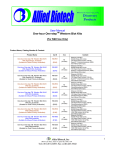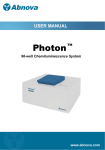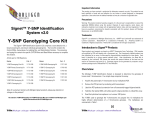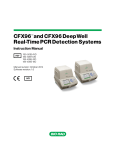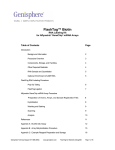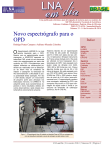Download Vantage microRNA Detection Kit
Transcript
Vantage™ microRNA Multiplex Detection Kit Oncology Detection Panel 1 Store at 2-8ºC Catalog No. 11831-050 50 Reactions Overview and Intended Use The Vantage™ microRNA Detection Kit offers researchers a fast and simple method for profiling the expression levels of multiple microRNAs from many different sample types including total RNA, enriched low molecular weight (LMW) RNA, and degraded RNA. The assays are configured on the xMAP® bead array allowing for the detection of multiple microRNAs in one sample. In addition, the 96-well format allows many samples to be analyzed in one run. MicroRNAs are a class of small molecules, about 21-23 nucleotides in length that regulate gene expression by various methods including translational repression, mRNA cleavage, methylation, and deadenylation. Differences in the expression levels of microRNAs have been associated with the pathogenesis of many diseases, including cancer. By measuring the expression levels of microRNAs, researchers obtain a better understanding of the processes involved in tumor development and progression. In addition, researchers can observe distinct expression patterns associated with particular stages of disease. The specific microRNAs detected in the Vantage™ Oncology Detection Panel 1 are given in Appendix A. These microRNAs have been associated with a variety of solid tumors (ref.1-5.) Principle of Method The Vantage™ microRNA Detection Kit utilizes a simple, hybridization procedure where samples are ready for detection on the Luminex® reader within 90 minutes. The samples are first labeled with multiple biotins using the Vantage™ microRNA Labeling Kit (Kit sold separately. See Cat. No. 11820-025). The biotinylated samples are incubated with a Bead Mix containing a mixture of different fluorescently dyed xMAP® beads. Each distinct xMAP® bead is coupled with a unique probe that recognizes a specific microRNA. The beads and sample are incubated at 60ºC allowing the microRNAs present in the sample to hybridize to the specific probes. Following hybridization, the samples are subjected to a high stringency wash to remove any non-specific binding. Finally, the samples are incubated with streptavidin-phycoerythrin (SAPE), which binds to the biotinylated microRNA hybridized to the xMAP® bead. The samples are read on Luminex® or Luminex-based instruments (e.g. BioPlex®) that detect the specific microRNAs present in the sample by their unique bead region and quantify the microRNAs by the intensity of the SAPE signal. Terms and Conditions By opening this Assay Product (which contains fluorescently labeled microsphere beads authorized by Luminex Corporation) or 2502 Urbana Pike Ijamsville, MD 21754 USA 301-874-4990 (phone) 301-874-4993 (fax) [email protected] www.marligen.com using this Assay Product in any manner, you are consenting to be bound by the following terms and conditions. You are also agreeing that the following terms and conditions constitute a legally valid and binding contract that is enforceable against you. If you do not agree to all of the terms and conditions set forth below, you must promptly return this Assay Product for a full refund prior to using it in any manner. You, the customer, acquire the right under Luminex Corporation’s patent rights, if any, to use this Assay Product or any portion of this Assay Product, including without limitation the microsphere beads contained herein, only with Luminex Corporation’s laser based fluorescent under the name Luminex Instrument. Safety and Use Statement All biological materials should be handled as potentially hazardous. Follow universal precautions as established by the Centers for Disease Control and Prevention and by the Occupational Safety and Health Administration when handling and disposing of potentially infectious or hazardous agents. This product is authorized for laboratory research use only. The product has not been qualified or found safe and effective for any human or animal diagnostic application. Uses other than the labeled intended use may be a violation of applicable law. If you have any questions concerning the use of this product, please contact Marligen Biosciences, Inc. at (866) 464 4990 or visit www.marligen.com. Components included with this kit: Component Hybridization Buffer Oncology Panel 1 Bead Mix Detection Reagent Wash Buffer SAPE Diluent Aluminum Plate Sealers Filter Plate Amount 1.25 mL 400 μL 55 μL 2 x 10 mL 25 mL 2 Each 1 Each Storage Conditions: Store all components at 2-8ºC. Handling Instructions: The kit is shipped on ice packs. Upon receipt, the components should be stored at 2-8ºC. Page 1 of 8 20215 Rev3 Materials and Equipment Required But Not Supplied: Nuclease-free PCR stripwell plate or nuclease-free PCR tubes 1.5 mL RNase free microfuge tubes Plugged micropipette tips Nuclease-Free water (Ambion Cat. No. AM9934 or equivalent) Microcentrifuge Thermocycler or heating block at 60ºC Plate Shaker Vortex Mixer Sonicating waterbath 96-well filter plate vacuum manifold Luminex Instrument Optional: RNase Inhibitor (Superase-In, Ambion Cat. No. AM2694 or equivalent) Important Information READ ENTIRE PROTOCOL BEFORE USE ADDITIONAL PRECAUTIONS SHOULD BE TAKEN TO PREVENT THE DEGRADATION OF RNA: RNases are very stable and robust enzymes that degrade RNA. Autoclaving solutions and glassware is not always sufficient to actively remove these enzymes. The first step when preparing to work with RNA is to create an RNase-free environment. The following precautions are recommended as your best defense against these enzymes. 1. The RNA area should be located away from microbiological work stations. 2. Clean, disposable gloves should be worn at all times when handling reagents, samples, pipettes, disposable tubes, etc. It is recommended that gloves are changed frequently to avoid contamination. 3. There should be designated solutions, tips, tubes, lab coats, pipettes, etc. for RNA only. 4. All RNA solutions should be prepared using at least 0.05% DEPC-treated autoclaved water or molecular biology grade nuclease-free water. 5. Clean all surfaces with commercially available RNase decontamination solutions. 6. When working with purified RNA samples, ensure that they remain on ice during downstream applications. Add 20 μL of the Vantage™ miR-plex Control into 33 μL of the Hybridization/Bead Mix at Hybridization Step 6, then follow protocol as described. Expected results for this assay control is shown in Appendix B. Note: There is no need to label this sample as the MiR-plex Control is already biotinylated. Set-up Prior to Starting Detection Protocol 1. Prepare labeled RNA. Prior to using this detection kit the microRNAs present in the samples must be labeled with biotin. To obtain optimal results, it is recommended that the Vantage™ microRNA Labeling Kit (Cat. No. 11820-025) is used to label samples. 2. Use 0.5-2 μg of labeled RNA per reaction. If duplicates are to be performed in the detection assay, double the amount of input RNA to be labeled and split the sample accordingly. Notes: Less than 0.5 μg/reaction may be used for some samples. However, it is recommended that a pilot study is carried out to determine the optimal amount of labeled RNA for a particular sample type. Refer to the protocol for Vantage™ microRNA Labeling Kit for further details on sample labeling. 3. Set thermocycler or heating block to 60°C. 4. Warm up the Luminex or Luminex-based instrument. Luminex Instrument Setup A. Set up the instrument as described in the user’s manual. Setup details specific to this kit are described below: 1. The XY platform heater should be off. 2. Set the events/bead to 50. 3. Set the minimum events to 20. 4. Enter the number of samples. 5. Set the sample size to 50 μL. 6. Set the flow rate to Fast. 7. Enter the bead region numbers as indicated in the table in Appendix A. 8. Check the probe height and adjust it, if necessary, to accommodate the filter plate. 9. Perform 1 prime with sheath fluid, 1 alcohol flush, and 2 sheath fluid washes. B. Adjust Luminex Instrument to High Gain Setting A high gain setting for the Luminex instrument is recommended to provide the best results. Each specific software used with the Luminex or Luminex-based instrument may have different instructions for obtaining the high gain setting. Below are instructions using the Luminex 2.3™ software. Please see manufacturer’s guidelines for instrument/software specific instructions (e.g. BioPlex®). Assay controls 1. Control 1 (bead 49) detects 5.8S RNA that is ubiquitously expressed in mammalian cells and is selected as a housekeeping gene for the Vantage™ Detection Kits. A signal of 4000-10000 MFI is typically observed when using 1-2 μg of high quality (RIN >8) total RNA. 2. An additional assay control is available from Marligen. The Vantage™ MiR-plex Control (Cat. No. 11830-001) contains 7 1. Create a new lot number for CAL2 and enter lot number with an synthetic biotinlyated RNAs including 5.8S, miR-21, and miR-9 HG at the end to designate High Gain. that are detected by the Vantage™ Oncology Detection Panel 1. 2502 Urbana Pike Ijamsville, MD 21754 USA 301-874-4990 (phone) 301-874-4993 (fax) [email protected] www.marligen.com Page 2 of 8 20215 Rev3 2. Record the CAL2 Calibrator target “RP1” which is usually around 3832. 3. Multiply the CAL2 Calibrator target “RP1” by 4.55 to get a new target value of approximately 17,436. 4. Enter the new Calibrator target “RP1” as the value for your New CAL2 lot. 5. Run the CAL2 calibration. Part II: Detection During this step, non-specific binding is removed by subjecting the reactions to high stringency washes. The specific microRNAs present in the sample are then detected by labeling the biotins with SAPE. Usage Notes 1. IMPORTANT: Do not allow the filter membrane to dry throughout the transfer, wash and detection steps. Detection Protocol 2. It is highly recommended to add 1 unit/μL of RNase Inhibitor to the SAPE Diluent. Part I: Hybridization 3. It is important to apply a slight vacuum of ~2-3 in Hg during all During this step the microRNAs present in the sample are wash steps. Higher vacuum may result in the loss of beads hybridized to their complimentary sequences on the and reduce bead count. xMAP® beads. 4. During all wash steps, cover unused wells with a plate sealer to ensure a seal necessary to pull a vacuum. 1. Vortex the Bead Mix vigorously for 20 seconds. 2. Sonicate the Bead Mix in a sonicating waterbath for A. Washes 2 minutes. 1. Pre-wet the wells in filter plate with 100 μL Wash Buffer. 3. Prepare the Hybridization/Bead Mix based on the number of 2. Transfer the hybridized reactions to each pre-wet well, cover reactions to be run in the assay as illustrated in Table 1. unused wells with a plate and apply vacuum to evacuate. 3. Remove vacuum and immediately add 100 μL of Wash Buffer Table 1 Hybridization/Bead Mix Preparation to each well and apply vacuum to remove buffer. Repeat this Volume per Volume per Volume per wash step for total of 3 washes. Component reaction 25 reactions 50 reactions Optional: For customer convenience, all washes are performed at Hybridization 25 µL 625 µL 1250 µL room temperature. As shown in Appendix B, increased assay Buffer specificity may be achieved by increasing temperature of wash Bead Mix 8 µL 200 µL 400 µL buffer to 60°C. However, please note that increasing the wash temperature may reduce overall assay signal. 4. Vortex the Hybridization/Bead Mix to ensure that it is fully 4. Remove vacuum and add 100 μL SAPE Diluent to each well and mixed. apply vacuum to remove diluent. Remove plate from manifold. 5. Add 33 μL of the Hybridization/Bead Mix into each well of a 5. Blot the bottom of the filter plate dry on a clean paper towel. nuclease-free PCR stripwell plate or into each nuclease-free PCR tube. B. SAPE Detection 6. Transfer 20 μL of the labeled RNA sample (prepared using 1. Prepare SAPE Detection Reagent as shown in Table 2. Vantage™ microRNA Labeling Kit) into the 33 μL of the Hybridization/Bead Mix in the PCR wells or tubes, mix by Table 2 SAPE Detection Reagent Preparation pipeting up and down. Note: If duplicates are to be performed, add 10 μL of the labeled RNA sample to the 33 μL of the Hybridization/Bead Mix in the PCR wells or tubes, bring the volume to 53 μL by adding 10 μL nuclease-free water, and mix by pipeting up and down. Component Detection reagent SAPE Diluent Volume per reaction Volume per 25 reactions Volume per 50 reactions 1 μL 25 μL 50 μL 100 μL 2.5 mL 5 mL IMPORTANT: As noted in the Set-up, duplicates should have double the amount of input RNA labeled with the Vantage™ Optional: Add 1 unit of RNase Inhibitor (e.g. Superase-In, Ambion Cat. No. AM2694 or equivalent) per microliter of SAPE Diluent. microRNA Labeling Kit. 2. Mix the SAPE Detection Reagent by vortexing. 7. Hybridize the reactions at 60ºC by using a thermocycler or 3. Add 100 μL of SAPE Detection Reagent into the washed well of heating block for one hour with continuous shaking at 400 rpm. the filter plate. Protect the reactions from light during this incubation. 4. Incubate the filter plate in dark for 30 minutes at room [Note: If shaking is not possible during this step, the MFI signals temperature. may be slightly reduced. However the overall results will not be [Note: To increase MFI signal, the plate may be shaken at 400 rpm affected.] during this incubation. Protect the reactions from light.] 2502 Urbana Pike Ijamsville, MD 21754 USA 301-874-4990 (phone) 301-874-4993 (fax) [email protected] www.marligen.com Page 3 of 8 20215 Rev3 Related Products: To see our full line of Vantage™ microRNA analysis products visit our website at www.marligen.com. 5. Add 100 μL of SAPE Diluent to each well and apply vacuum to remove buffer. Repeat this wash step for total of 3 washes. 6. Blot the bottom of the filter plate dry on a clean paper towel. 7. Add 100 μL of SAPE Diluent into each well to resuspend the beads in the filter plate by shaking for 2 minutes at 400 rpm or by pipeting up and down. 8. Read the filter plate in Luminex instrument at high gain setting (see Luminex Instrument Set-up). DATA Analysis 1. Use the MFI data output from the Luminex Instrument to collect the raw MFI. 2. Subtract the background MFI in negative control from the Sample MFI. Note: If after subtraction of background MFI signal is negative, regard results as zero i.e., that specific microRNA is not detectable in the sample. 3. Control 1 (bead 49) detects 5.8S RNA that is ubiquitously expressed in mammalian cells and is selected as a housekeeping microRNA gene for the Vantage™ Oncology Panel 1. When comparing two samples, normalize the MFI with Control 1. Normalization factor = Limited Use License and Use Restrictions A limited, research use only, license is conveyed to the purchaser of this product. Trademarks Vantage™ is a trademark of Marligen Biosciences, Inc. Luminex® and xMAP® are trademarks of Luminex Corporation. References 1. Calin GA, Sevignani C, Dumitru CD, Hyslop T, Noch E, Yendamuri S, Shimizu M, Rattan S, Bullrich F, Negrini M, Croce CM. (2004). Human microRNA genes are frequently located at fragile sites and genomic regions involved in cancers. Proc. Natl. Acad. Sci., 104(19) pp8017-8022. 2. Volinia S, Calin GA, Liu CG, Ambs S, Cimmino A, Petrocca F, Visone R, Iorio M, Roldo C, Ferracin M, Prueitt RL, Yanaihara N, Lanza G, Scarpa A, Vecchione A, Negrini M, Harris CC, Croce CM. (2006). A microRNA expression signature of human solid tumors defines cancer gene targets. Proc. Natl. Acad. Sci., 103(7) pp2257-2261. 3. Blower PE, Verducci JS, Lin S, Zhou J, Chung JH, Dai Z, Liu CG, Reinhold W, Lorenzi PL, Kaldjian EP, Croce CM, Weinstein JN, Sadee W. (2007). MicroRNA expression profiles for the NCI-60 cancer cell panel. Mol. Cancer Ther. 6 pp1483-1491. 4. Gaur A, Jewell DA, Liang Y, Ridzon D, Moore JH, Chen C, Ambros VR, Israel MA. (2007). Characterization of microRNA expression levels and their biological correlates in human cancer cell lines. Cancer Res. 67 pp2456-2468. 5. Yu SL, Chen HY, Chang GC, Chen CY, Chen HW, Singh S, Cheng CL, Yu CJ, Lee YC, Chen HS, Su TJ, Chiang CC, Li HN, Hong QS, Su HY, Chen CC, Chen WJ, Liu CC, Chan WK, Chen WJ, Li KC, Chen JJ, Yang PC. (2008) MicroRNA signature predicts survival and relapse in lung cancer. Cancer Cell. 13(1) pp48-57. MFI of Control 1 in Control Sample MFI of Control 1 in Tumor or Treated Sample For example: Control 1 in normal tissue: MFI = 20000 Control 1 in tumor tissue: MFI = 16000 20000 Normalization factor = 16000 = 1.25 4. Then multiply Tumor or Treated Sample MFI by the normalization factor 1.25. 5. The fold change in microRNA expression can be calculated by dividing the normalized MFI for the Tumor or Treated Sample by the MFI for the Control Sample. Plot results using Excel or equivalent. Note that if an MFI value is zero (or close to 0 {<10}), the microRNA is not detectable in the sample and should be considered as not expressed. 6. To determine assay precision, calculate standard deviation (SD) and assay coefficient of variation (CV). [%CV =SD/mean x 100%]. Assay CVs are typically less than 5% for technical replicates. Technical Support For further technical assistance please contact us at [email protected]. (866) 464.4990.ext.102 or Technical support and troubleshooting guides for these products can also be found on our website at www.marligen.com. 2502 Urbana Pike Ijamsville, MD 21754 USA 301-874-4990 (phone) 301-874-4993 (fax) [email protected] www.marligen.com Page 4 of 8 20215 Rev3 Vantage™ microRNA Multiplex Detection Kit Oncology Detection Panel 1 Store at 2-8ºC APPENDIX A: TABLE OF microRNAs AND xMAP® BEAD REGIONS The sequences and nomenclature of the mature microRNAs are extracted from The miRBase Sequence Database version 12.0, released in September 2008, in Sanger Institute in UK. Names annotated with * indicate a mature microRNA sequence that originated from a stem-loop molecule that generated two mature microRNA sequences. In these cases, one mature sequence has a standard name while the other sequence from the same stem-loop has an annotated name(*). The nomenclature of the sequences detected by Vantage™ Oncology Detection Panel 1 is designated using the human sequence nomenclature. The equivalent mouse and rat sequences are indicated in the table below. xMAP® Bead Number Human microRNA Nomenclature Human microRNA mature sequences Equivalent Mouse (Mus musculus) Nomenclature Equivalent Rat (Rattus norvegicus) Nomenclature 1 hsa-let-7a UGAGGUAGUAGGUUGUAUAGUU mmu-let-7a rno-let-7a 2 hsa-let-7c UGAGGUAGUAGGUUGUAUGGUU mmu-let-7c rno-let-7c 3 hsa-let-7g UGAGGUAGUAGUUUGUACAGUU mmu-let-7g 4 hsa-let-7i UGAGGUAGUAGUUUGUGCUGUU mmu-let-7i rno-let-7i 5 hsa-miR-100 AACCCGUAGAUCCGAACUUGUG mmu-miR-100 rno-miR-100 6 hsa-miR-106a AAAAGUGCUUACAGUGCAGGUAG mmu-miR-106a 7 hsa-miR-10a UACCCUGUAGAUCCGAAUUUGUG mmu-miR-10a rno-miR-10a-5p 8 hsa-miR-10b UACCCUGUAGAACCGAAUUUGUG mmu-miR-10b rno-miR-10b 9 hsa-miR-125a-5p UCCCUGAGACCCUUUAACCUGUGA mmu-miR-125a-5p rno-miR-125a-5p 10 hsa-miR-125b UCCCUGAGACCCUAACUUGUGA mmu-miR-125b-5p rno-miR-125b-5p 11 Not in use 12 Not in use 13 hsa-miR-132* ACCGUGGCUUUCGAUUGUUACU 14 hsa-miR-135a UAUGGCUUUUUAUUCCUAUGUGA mmu-miR-135a rno-miR-135a 15 hsa-miR-136 ACUCCAUUUGUUUUGAUGAUGGA mmu-miR-136 rno-miR-136 16 hsa-miR-138 AGCUGGUGUUGUGAAUCAGGCCG mmu-miR-138 rno-miR-138 17 hsa-miR-141* CAUCUUCCAGUACAGUGUUGGA mmu-miR-141* 18 hsa-miR-16 UAGCAGCACGUAAAUAUUGGCG mmu-miR-16 rno-miR-16 19 hsa-miR-17 CAAAGUGCUUACAGUGCAGGUAG mmu-miR-17 rno-miR-17 20 hsa-miR-181b AACAUUCAUUGCUGUCGGUGGGU mmu-miR-181b rno-miR-181b 21 hsa-miR-185 UGGAGAGAAAGGCAGUUCCUGA mmu-miR-185 rno-miR-185 22 hsa-miR-195 UAGCAGCACAGAAAUAUUGGC mmu-miR-195 rno-miR-195 2502 Urbana Pike Ijamsville, MD 21754 USA 301-874-4990 (phone) 301-874-4993 (fax) [email protected] www.marligen.com Page 5 of 8 Notes 20215 Rev3 xMAP® Bead Number Human microRNA Nomenclature Human microRNA mature sequences Equivalent Mouse (Mus musculus) Nomenclature Equivalent Rat (Rattus norvegicus) Nomenclature 23 hsa-miR-199a-5p CCCAGUGUUCAGACUACCUGUUC mmu-miR-199a-5p rno-miR-199a-5p 24 hsa-miR-200b* CAUCUUACUGGGCAGCAUUGGA mmu-miR-200b* 25 hsa-miR-205 UCCUUCAUUCCACCGGAGUCUG mmu-miR-205 rno-miR-205 26 hsa-miR-20a UAAAGUGCUUAUAGUGCAGGUAG mmu-miR-20a rno-miR-20a 27 hsa-miR-21 UAGCUUAUCAGACUGAUGUUGA mmu-miR-21 rno-miR-21 28 hsa-miR-210 CUGUGCGUGUGACAGCGGCUGA mmu-miR-210 rno-miR-210 29 hsa-miR-212 UAACAGUCUCCAGUCACGGCC mmu-miR-212 rno-miR-212 30 hsa-miR-218 UUGUGCUUGAUCUAACCAUGU mmu-miR-218 rno-miR-218 31 hsa-miR-23b* UGGGUUCCUGGCAUGCUGAUUU 32 hsa-miR-24-2* UGCCUACUGAGCUGAAACACAG mmu-miR-24-2* rno-miR-24-2* 33 hsa-miR-27a* AGGGCUUAGCUGCUUGUGAGCA mmu-miR-27a* rno-miR-27a* 34 hsa-miR-29a* ACUGAUUUCUUUUGGUGUUCAG mmu-miR-29a* rno-miR-29a* 35 hsa-miR-29b-2* CUGGUUUCACAUGGUGGCUUAG 36 hsa-miR-29c* UGACCGAUUUCUCCUGGUGUUC mmu-miR-29c* rno-miR-29c* 37 hsa-miR-30d UGUAAACAUCCCCGACUGGAAG mmu-miR-30d rno-miR-30d 38 hsa-miR-34a UGGCAGUGUCUUAGCUGGUUGU mmu-miR-34a rno-miR-34a 39 hsa-miR-34b* UAGGCAGUGUCAUUAGCUGAUUG 40 hsa-miR-9 UCUUUGGUUAUCUAGCUGUAUGA mmu-miR-9 rno-miR-9 41 hsa-miR-93 CAAAGUGCUGUUCGUGCAGGUAG mmu-miR-93 rno-miR-93 42 hsa-miR-95 UUCAACGGGUAUUUAUUGAGCA 43 hsa-miR-96 UUUGGCACUAGCACAUUUUUGCU mmu-miR-96 rno-miR-96 44 hsa-miR-99a AACCCGUAGAUCCGAUCUUGUG mmu-miR-99a rno-miR-99a 45 hsa-miR-137 UUAUUGCUUAAGAAUACGCGUAG mmu-miR-137 rno-miR-137 46 hsa-miR-182* UGGUUCUAGACUUGCCAACUA 47 hsa-miR-221 AGCUACAUUGUCUGCUGGGUUUC mmu-miR-221 rno-miR-221 48 hsa-miR-372 AAAGUGCUGCGACAUUUGAGCGU 49 NA Control 1 2502 Urbana Pike Ijamsville, MD 21754 USA 301-874-4990 (phone) 301-874-4993 (fax) [email protected] www.marligen.com Page 6 of 8 Notes rno-miR-29b-2* rno-miR-34b 20215 Rev3 APPENDIX B PERFORMANCE CHARACTERISTICS OF VANTAGE™ ONCOLOGY DETECTION KITS 1. Protocol Overview 2. Assay Sensitivity a. The limit of detection of the Vantage™ microRNA Detection Kits for specific microRNAs was calculated using synthetic microRNAs labeled with the Vantage™ microRNA Labeling Kit (Cat. No. 11820-025) and detected using Oncology Detection Panel 1 (Cat. No. 11831-050). Limit of Detection Range : 0.03-0.1 pg (5-15 attomoles) b. The limit of detection of the Vantage™ microRNA Detection Kits in tissues was calculated using total RNA extracted from human brain labeled with the Vantage™ microRNA Labeling Kit (Cat. No. 11820-025) and detected using Oncology Detection Panel 1 (Cat. No. 11831-050). Limit of Detection Range : 3-40 ng total RNA 3. Assay Specificity a. No Cross-reactivity Observed Between Unrelated Sequences 200 pg of synthetic miR-210 labeled with the Vantage™ microRNA Labeling Kit (Cat. No. 11820-025) and detected using Oncology Detection Panel 1 (Cat. No. 11831-050). MiR-210 lacks homology with any other sequence in the Oncology Detection Panel 1 and shows > 1% cross-reactivity with any other miR assay in this multiplex. 2502 Urbana Pike Ijamsville, MD 21754 USA 301-874-4990 (phone) 301-874-4993 (fax) [email protected] www.marligen.com Page 7 of 8 20215 Rev3 b. Balance Between Specificity and Sensitivity for Closely Related Sequences 400 attomoles of synthetic biotinylated miR-100 was incubated with the Vantage™ Oncology Detection Panel 1 (Cat. No. 11831-050). The assay was performed using the protocol as described in the package insert except different temperatures were employed at the wash step. Results show <10% cross reactivity with very similar sequences under standard protocol conditions (25°C). Negligible cross reactivity was observed for all of the other miR sites. Specificity for miR-100 increased by raising the wash temperature but the overall assay signal is reduced. In this assay, high sensitivity and low cross reactivity are maintained following the standard protocol, although greater specificity can be obtained by increasing wash temperature. 400 attomoles of synthetic let-7a was incubated with the Vantage™ Oncology Detection Panel 1 (Cat. No. 11831-050). The assay was performed using the protocol described in the package insert, except the wash step was also carried out at 60°C. With the exception of the very similar let-7c sequence, all miR sites in the assay show negligible cross-reactivity under standard protocol conditions. Specificity for let-7a increases significantly by increasing the wash temperature, although this decreases the overall assay signal. For the most sensitive assay, follow the standard protocol, but for higher specificity, increase the wash temperature. 4. Vantage™ MiR-plex Control Expected Results Vantage™ Oncology Breast Cancer Pancreatic Ovarian Cardiac microRNA Detection Panel 1 Panel 1 Cancer Panel 1 Cancer Panel Panel 1 Detection (47-plex) (8-plex) (12-plex) (8-plex) (10-plex) Kit Cat. No. 11831-050 11833-050 11832-050 11834-050 11835-050 microRNA Expected MFI Values miR-1 Low miR-107 Low miR-126 Low miR-203 Low miR-21 High High High High High miR-9 High 5.8S Medium Medium Medium Medium Medium 2502 Urbana Pike Ijamsville, MD 21754 USA 301-874-4990 (phone) 301-874-4993 (fax) [email protected] www.marligen.com Page 8 of 8 Diabetes Panel 1 (11-plex) Hypoxia Panel 1 (10-plex) 11836-050 11837-050 Low High Medium Low High Medium 20215 Rev3









